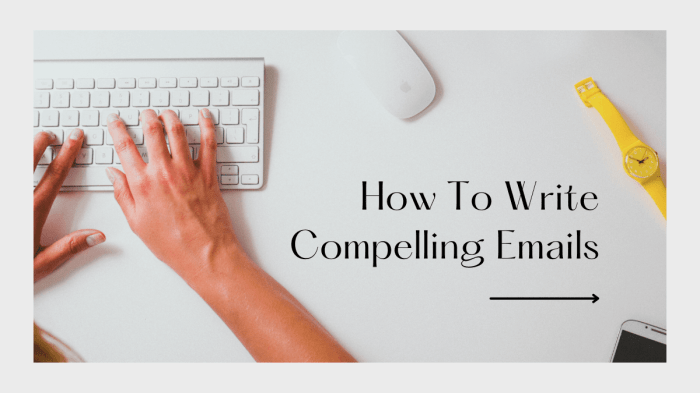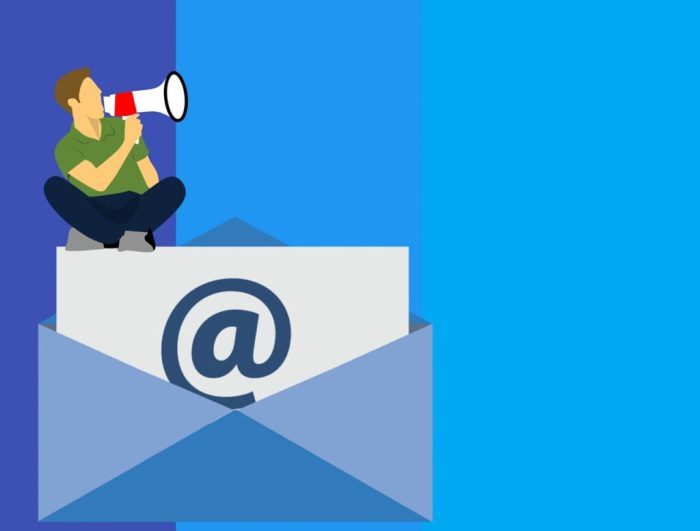Writing Compelling Emails sets the stage for unlocking the secrets to captivating your audience through the power of words. Dive into a world where every message you craft leaves a lasting impact and yields remarkable results.
From understanding your audience to crafting attention-grabbing subject lines and designing visually appealing emails, this guide will equip you with the tools to revolutionize your email communication strategy.
Importance of Writing Compelling Emails

In today’s digital age, writing compelling emails has become a crucial skill in professional communication. With the sheer volume of emails flooding inboxes daily, it is essential to craft content that stands out and grabs the recipient’s attention.Compelling emails have the power to engage the reader, convey the message effectively, and drive action. They can make a lasting impression, build relationships, and ultimately lead to desired outcomes.
Whether it’s a marketing campaign, a business proposal, or a simple follow-up, the impact of a well-written email cannot be underestimated.
Successful Email Campaigns
One example of a successful email campaign that showcases the power of compelling content is Airbnb’s personalized recommendation emails. By analyzing user data and preferences, Airbnb sends tailored recommendations that resonate with recipients, leading to higher engagement and conversion rates.Another example is Starbucks’ mobile app email campaigns, which use interactive content and personalized offers to entice customers to visit their stores.
These emails not only drive traffic but also foster customer loyalty and increase sales.
Higher Open and Response Rates
Engaging email content is more likely to be opened, read, and acted upon by recipients. By incorporating attention-grabbing subject lines, personalized messages, and clear calls to action, compelling emails can significantly boost open and response rates.Research shows that emails with personalized subject lines are 26% more likely to be opened. Moreover, emails that provide value to the recipient, such as exclusive offers or relevant content, are more likely to elicit a response.
By focusing on creating compelling emails, businesses can improve their communication effectiveness and achieve better results.
Understanding Your Audience
When it comes to writing compelling emails, knowing your audience is key. Understanding who you are communicating with allows you to tailor your message in a way that resonates with them.
Significance of Audience Research
To craft effective emails, start by conducting audience research. This involves gathering data on your target audience’s demographics, preferences, behavior patterns, and interests. By understanding these aspects, you can create content that speaks directly to their needs and desires.
- Utilize surveys and feedback forms to gather insights from your audience.
- Analyze data from email marketing tools to track open rates, click-through rates, and engagement levels.
- Monitor social media interactions and comments to gauge audience sentiment.
Segmenting Email Lists
Segmenting your email lists based on audience preferences and behaviors can significantly improve the effectiveness of your campaigns. By dividing your subscribers into smaller groups, you can send targeted messages that are more relevant to their interests.
- Segment based on demographics such as age, location, or gender.
- Use past purchase behavior to send personalized recommendations or promotions.
- Create separate lists for different stages of the customer journey, such as leads, prospects, and loyal customers.
Crafting Attention-Grabbing Subject Lines: Writing Compelling Emails
When it comes to writing compelling emails, crafting attention-grabbing subject lines is key to getting your recipients to open and engage with your message. Your subject line is the first thing that people see, so it needs to be enticing enough to make them want to click.
Tips for Creating Enticing Subject Lines
- Keep it short and sweet: Aim for around 6-8 words to ensure your subject line is concise and to the point.
- Use action words: Verbs like “Discover,” “Join,” or “Get” can create a sense of urgency and encourage recipients to open the email.
- Personalize when possible: Including the recipient’s name or relevant details can make the subject line feel more tailored to their interests.
Importance of Clarity and Relevance
Clarity and relevance are crucial when it comes to subject lines. If your subject line is vague or doesn’t relate to the content of the email, recipients are less likely to open it. Make sure your subject line clearly communicates what the email is about and why it’s relevant to the recipient.
Examples of High-Open Rate Subject Lines
-
“Exclusive Offer Inside: 50% Off Your Favorite Brands!”
This subject line offers a clear benefit to the recipient (a discount) and creates a sense of urgency with the word “Exclusive.”
-
“Don’t Miss Out: Limited-Time Free Trial for Our New Product!”
By emphasizing the limited-time offer and the opportunity to try something new for free, this subject line entices recipients to open the email.
Writing Engaging Email Content
When it comes to crafting engaging email content, it’s important to start with a strong introduction that hooks the reader’s attention right away. This could be a compelling story, a thought-provoking question, or a relevant statistic that piques curiosity.
After you’ve captured their interest, it’s crucial to have a clear call to action that tells the recipient what you want them to do next. Whether it’s clicking a link, replying to the email, or making a purchase, make sure your call to action is direct and easy to follow.
Personalizing Email Content
One effective strategy for engaging email content is personalization. This involves tailoring your message to resonate with the recipient on a personal level. Use their name, reference previous interactions, or segment your email list based on interests to make your content more relevant to each individual.
- Address the recipient by their name to create a sense of connection.
- Reference past purchases or interactions to show that you value their loyalty.
- Segment your email list based on demographics or behavior to send targeted content.
Maintaining a Conversational Tone
Another key aspect of engaging email content is maintaining a conversational tone. Avoid using overly formal language or industry jargon that can alienate readers. Instead, write as if you’re having a one-on-one conversation with a friend, keeping your message clear, concise, and easy to understand.
- Avoid technical jargon that might confuse the reader.
- Use simple language and short sentences for better readability.
- Inject personality into your writing to make it more engaging and relatable.
Designing Visually Appealing Emails

Visuals play a crucial role in enhancing the overall appeal of emails. They grab the reader’s attention, make the content more engaging, and help convey information more effectively. Incorporating images, videos, and other multimedia elements in emails can significantly increase click-through rates and drive user engagement.
Best Practices for Incorporating Visuals
When adding visuals to your emails, make sure they are relevant to the content and enhance the message you are trying to convey. Use high-quality images that are clear and visually appealing. Videos should be short, engaging, and autoplay should be avoided as it can be distracting. Additionally, consider using GIFs to add a touch of interactivity to your emails.
Importance of Responsive Design, Writing Compelling Emails
Responsive design is essential for ensuring that your emails display well on various devices, including desktops, laptops, tablets, and smartphones. Make sure your email templates are mobile-friendly and adjust to different screen sizes. Test your emails on different devices and email clients to ensure they look good everywhere. A responsive design not only improves user experience but also boosts open and click-through rates.
